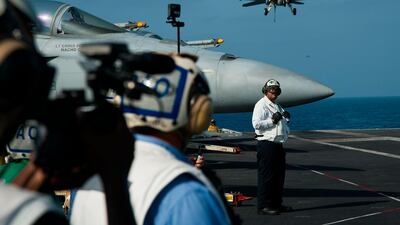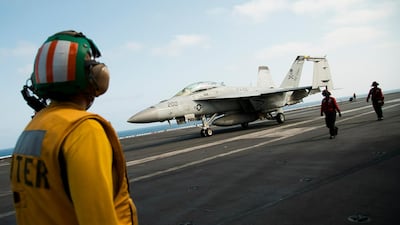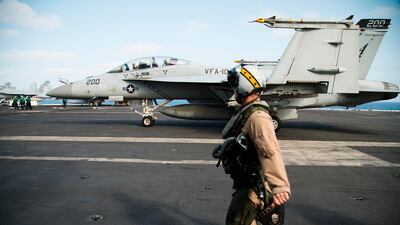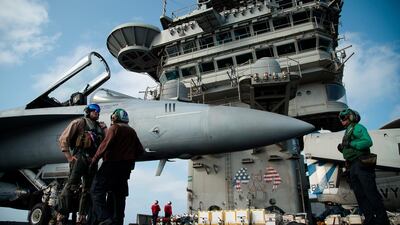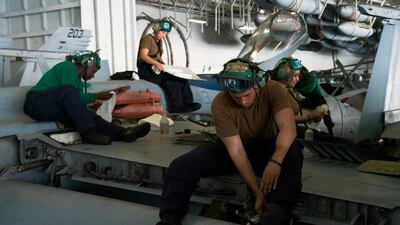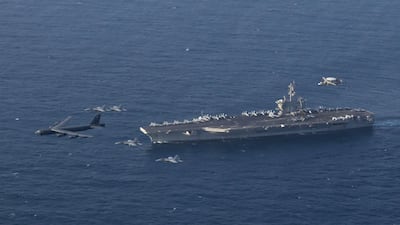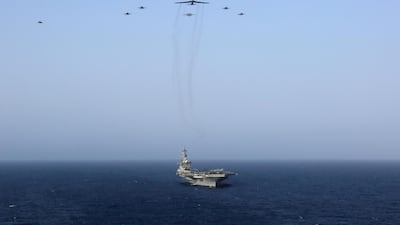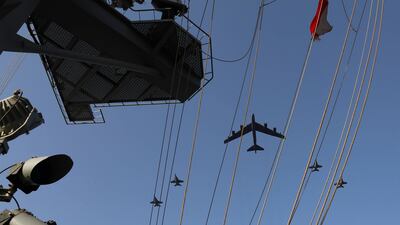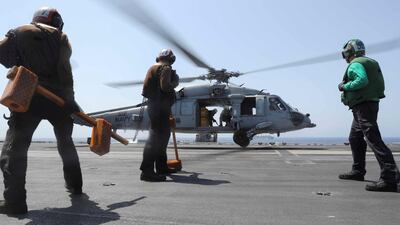The US aircraft carrier sent to the Gulf region to respond to Iranian threats has stayed out of the Strait of Hormuz to avoid unnecessary escalation.
The carrier group led by the USS Abraham Lincoln has remained hundreds of kilometres from the vital strait – only 33 kilometres at its narrowest point – through which a third of the world's oil supplies pass.
But officers aboard say they are ready and capable of responding to threats.
The waterway is busy with tankers and cargo ships, but US warships have for years also passed unimpeded, although the American navy has reported vessels being buzzed by Iranian speedboats.
"You don't want to inadvertently escalate something," Capt Putnam Browne, the commanding officer of the Lincoln, told AP.
Mohammad Jokar, deputy head of parliamentary affairs for Iran's Islamic Revolutionary Guard Corps, said in May that its missiles could easily hit US ships after the USS McFaul and USS Gonzalez destroyers passed through the strait.
Asked about why the carrier had not gone through the strait, Rear Adml John Wade, the commander of the strike group, said that his forces could "conduct my mission wherever and whenever needed".
In May, the White House sent the USS Lincoln and B-52 bombers to the Arabian Gulf.
The US also plans to send 900 more troops to the Middle East and extend the stay of another 600 as tens of thousands of others are also posted across the region.
The situation arises from President Donald Trump's withdrawal last year from the 2015 nuclear deal with Tehran and world powers, and his reimposition of sanctions on Iran.
Mr Trump has said that the deal did not adequately address Iran’s ballistic missile programmes or support for regional proxies.
While the carrier group's decision to keep out of the Strait of Hormuz is a departure from previous operations, it is not a fixed order.
On May 10, Vice Adml Jim Malloy, commander of the US Navy’s Bahrain-based Fifth Fleet and the man who oversees US naval forces in the Middle East, said would not hesitate to order the carrier group through Hormuz if needed.
Accompanying the carrier to the Middle East are three destroyers – the USS Bainbridge, the USS Mason and the USS Nitze – and guided-missile cruiser the USS Leyte Gulf.
The US has made a point of displaying its arsenal and American readiness in the region. On Sunday, the Air Force announced a B-52 conducted a training exercise with the USS Lincoln that included "simulated strike operations".
On Monday, F/A-18s flew manoeuvres over the carrier.
It is not uncommon for Iran's Revolutionary Guard naval forces to shadow American warships in the strait.
They have also run snap missile launches, fired machineguns and flown drones near US carriers.
The moves risk miscalculation but Iran is also an expert in brinkmanship and is known to scale back the most provocative actions at times of acute tension.
Iran has threatened on several occasions in recent months to close the strait if American sanctions preventing Tehran exporting oil are not lifted.
The move would risk a major response and may be part of the US calculation to send the carrier group.
“They do impose a threat to our operations but also to the safety and security of commerce and trade going through the Strait of Hormuz, and that’s why we are here,” Rear Adml Wade said.
Capt Chris Follin, the commodore of the destroyer strike group travelling with the carrier, did not express concern about tension.
“I wouldn’t want to go against that,” Capt Follin said, nodding toward the ship’s sailors and warplanes. “Our mission is just to keep the peace.”
